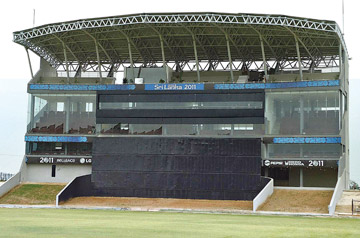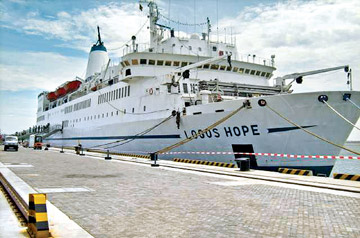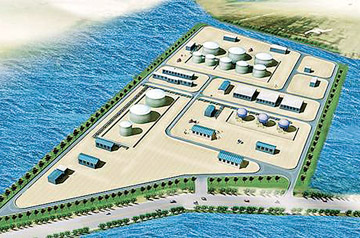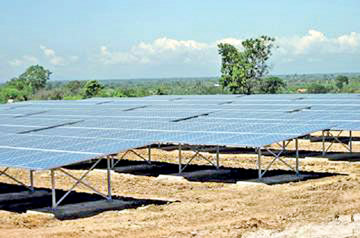Hambantota to be Lanka’s best planned city
By Shirajiv Sirimane

The venue for the Commonwealth Games, Suriyaweva Stadium |

The book ship Logos Hope at Ruhunu Magampura Harbour. |

The oil tank farm at the Ruhunu Magampura Harbour |
 |
| The solar park |
Just two or three decades ago, the only tarred road leading to
Kataragama was confined to single file traffic. By next year Hambantota
would have four flyovers. The four-lane carpeted road around the harbour
would be expanded to six lanes, envisaging the future economic activity
in the city.
The southern town of Hambantota, currently witnessing a spate of
development activities, is set to witness the construction of Sri
Lanka’s biggest investment zones at its port site - its size being
almost equal to all investment zones in the country put together.
Undoubtedly, the first major development project that put Hambantota
in the global investment map was the Ruhunu Magampura harbour.
Subsequent to the construction of the harbour, over 100 hectares were
allocated for an investment zone. Tenders were called for and over 70
investors responded of which 14 were finally shortlisted. The total
amount pledged was one billion US dollars.
Chairman Sri Lanka Ports Authority, Dr. Priyath Wickrama said
investment proposals for the second stage would be called in October.
They are looking to secure investments to the country to the value of
five billion US dollars by 2015, including for projects in the Colombo
and Trincomalee harbours. “This would enable them to pay back the loan
with ease,” Dr. Wickrama said adding that modifications were done to the
entry point of the port while further dredging was carried out to enable
even larger ships to enter the harbour.
Commenting on the negative propaganda, he said the private sector is
very cautious when making investments and if there were rocks or ships
were unable to sail to the Ruhunu Magampura Port, they would not have
invested one billion US dollars on the project. “The private sector
would not take risks,” he said.
No red tape
He promised that the red tape would be minimal at the Ruhunu
Magampura Port and even a truck driver would be able to collect the
cargo unlike at the Colombo Port where a person has to visit 13
different places before getting the cargo released.
The tank farm project and administrative building at the Hambantota
Port would be some of the key features of this development project.
The bunkering facility and tank farm project will consist of 14 tanks
that will offer a total capacity of 80,000mt.
Eight tanks will be used for bunkering while the other six will be
utilised, three each, as aviation fuel and LPG tanks.
The project will cost US$ 76,581,774 and China Huanqiu Contracting
and Engineering Corporation Works would be the contractor.
“The key to the success of this project is the online facility we
would be introducing at the Ruhunu Magampura Harbour”, Dr. Wickrama
said.
The city would be linked to the port by the extension of the highway
from Matara and the rail link to Hambantota too would be a reality.
Chairman Airport and Aviation Services Ltd., Prasanna Wickramasuriya
said the Hambantota International Port project is on schedule and
aircraft would be able to land by November 2012.
The passenger terminal could accommodate 10,000 passengers and the
airport will have the capacity of handling 45,000 metric tons of cargo,
he said. The Government plans to complete all basic facilities and
requirements including the runway, taxiways and parking facilities for
10 aircraft in the first phase of the Mattala Airport at a cost of US$
210 million (Rs.23 billion) with financial assistance from the Chinese
Government.
Solar park
The Buruthakanda Solar Park will be the first and only
commercial-scale solar power station in Sri Lanka.
The first stage of the project will be financed by the Japanese
Government while the Korean Government will finance the second stage.
Japan has already provided Rs. 1,024 million for the first stage under
which 737 KW of power will be added to the national grid upon
completion. Work relating to the construction of the first stage is
expected to be completed by August next year.
The second stage of the power garden which will open in April will
add 500 KW of power to the national grid. Solar panels are now fixed in
an area of over two acres in Hambantota. The park, when completed, would
add 1.2 megawatts to the national grid. The total investment on this
project by both Korea and Japan is US$ 13.4 million with the Japanese
Government investing US$ 8.9 million.
Commonwealth Games
Hambantota is looking forward to hosting the 2018 Commonwealth Games
and the bid would place Hambantota as a focal point in the world
sporting arena. “Since the surprise decision in April 2010, Hambantota
has moved from rank outsiders to serious contenders and is growing
increasingly confident ahead of success at the Commonwealth Games
Federation Assembly in St Kitts and Nevis on November 11, where the host
city will be chosen”, an Astralian newspaper said.
“There is a general feeling that emerging countries should also be
given the opportunity. There are more countries like us who can emerge
and do well,” Chairman Organising Committee, Ajith Nivard Cabraal said.
He said the bulk of the funding for the Games would come from the
private sector. The Games Village is designed as six interlinked
clusters of tropical medium-rise living, set amidst a garden oasis of
boulevards, plazas, dense planting, green belts and water features,
reflecting Sri Lanka’s lush, green environment.
Three of the six clusters will be privately developed and sold as
condominiums. The other three clusters will be privately developed as
student accommodation for the on-site university.
The student accommodation will be developed on the basis of the
condominium design to avoid disparity in provision. It will be developed
as investment property for student living as well as for employees of
the business and IT park and university.
All apartments will be air-conditioned and will be fully furnished
with amenities such as televisions, refrigerators, electric kettles,
washing machines, irons and ironing boards. All residential entrances,
corridors and lifts will be fully accessible for wheelchair use.
Free fibre-optic telecommunications and local wireless networks will
be available throughout the residential areas, with internet connections
available in the apartments. Each apartment will also be fitted with
cable TV. MP Namal Rajapaksa told the Sunday Observer that the
infrastructure for the Games would be put to maximum use afterwards.
Zoological gardens, a mini outdoor zoo, and modern administration
building too are being constructed in Hambantota which would be Sri
Lanka’s most carefully planned city. |

